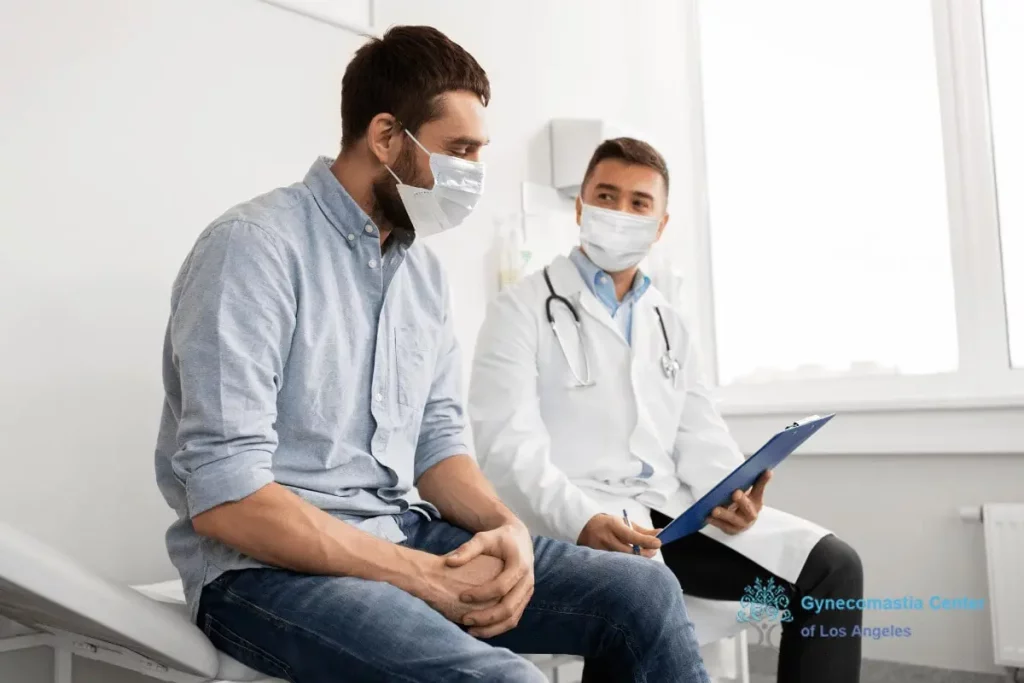How much do you know of Unilateral Gynecomastia vs Bilateral Gynecomastia? Gynecomastia is a condition that affects nearly 50% to 65% of all men at some point in their lives. Some boys experience body deformity in their teenage years. Older men can experience male breast growth as they age. The problem is caused by a fluctuation of female to male hormones, causing breast tissue to expand beyond masculine levels.
If you have gynecomastia, you should know that there are various grades of growth, each with its own individual types of treatment. There is also unilateral and bilateral gynecomastia, which we will discuss today.
When discussing unilateral gynecomastia vs bilateral gynecomastia, we are referring to symmetry. Some boys and men have breasts on both sides of the chest. Others have only one breast that is enlarged. Here are the problems that can occur when you have either one or two breasts, and the treatments you’ll want to pursue to eradicate gynecomastia from your life permanently.
What is Gynecomastia?
Gynecomastia is a benign condition that causes glandular breast tissue to proliferate. For most men, the condition is painless. Other men can experience discomfort or pain. The condition can also lead to extreme psychological distress. Having male breasts can make you feel different, socially anxious, and depressed.
Why Does Gynecomastia Form?
Gynecomastia results from a high estrogen-to-testosterone ratio. Either estrogen in the body spikes or testosterone becomes deficient. This can occur because of medications you may be taking, obesity, genetics, and lifestyle habits, such as illicit drug use, alcoholism, and steroid abuse.
What is Unilateral Gynecomastia and Why Does It Form?
In a small percent of men with gynecomastia, only one side of the chest becomes enlarged. While all forms of gynecomastia can be difficult to live with, one-sided gyno tends to cause the most psychological discomfort.
Having only one female-like breast makes the condition highly noticeable. Men with this form of the disorder avoid taking their shirts off for activities like swimming, exercising, and intimacy while other men are quick to rip their shirts off at the first opportunity.
For reasons experts still aren’t aware of, unilateral gynecomastia tends to form on the left side of the chest. The condition may bring tenderness, but not always. The common consensus is that one-sided gynecomastia forms during puberty. Other experts believe that certain drugs can contribute to the condition, such as Finasteride or “Propecia” which is used to treat hair loss.
Unilateral gynecomastia surgery is the only way find permanent relief from one-sided male breast growth.
Unilateral Gynecomastia Could Be Breast Cancer
Male breast cancer is rare, making up around 1% of all breast cancer diagnoses. That being said, male breast cancer could present itself as looking similar to unilateral gynecomastia vs bilateral gynecomastia. You should see a doctor for a biopsy and checkup if your male breast growth is accompanied by a firm mass, changes to the skin, enlarged lymph nodes in the arm pit, and drainage from the nipple.
What are the Symptoms of Unilateral Gynecomastia?
The condition poses no additional health risk when one-sided gynecomastia is not breast cancer. The severity of the breast growth can vary from one patient to another. The most significant symptoms are mental, with the condition profoundly affecting confidence and self-esteem.

What is Bilateral Gynecomastia?
For most men with gynecomastia, both sides of the chest are affected. The growth may not always be symmetrical, but both sides show some level of excess tissue.
The condition presents itself as excess fatty tissue, glandular tissue, fibrous tissue, or a combination of all three.
Both unilateral gynecomastia vs bilateral gynecomastia can be self-diagnosed by feeling for a button-sized growth underneath the nipple. The condition may also present as puffy nipples, even if the breast growth is mild.
The symptoms for unilateral gynecomastia vs bilateral gynecomastia are the same. You may experience tenderness in one or both breasts as well as psychological discomfort. It would help if you also watched for changes that could indicate breast cancer. Some experts believe that men who experience gynecomastia are at a higher risk of developing breast cancer than men without.
What are the Grades of Bilateral Gynecomastia?
There are various grades of gynecomastia. The growth could be:
- Mild without excess skin. This is considered the first grade of gynecomastia. The tiny enlargement you experience with this stage may easily be hidden by clothing. There may be puffiness to the nipples, which is slightly more difficult to hide. You may have mild unilateral gynecomastia or mild bilateral gynecomastia.
- Moderate without excess skin. This gynecomastia stage presents as broader growth that expands throughout the chest. Some teen boys and men can hide this level of breast growth by layering their clothing or by wearing thicker shirts. You know you have this stage of gynecomastia when the chest feels tight and firm under the nipple/areolar complex. The outer area is typically soft and fatty.
- Moderate with minor excess skin. Boys and men with this stage of gynecomastia experience excess skin around the chest. The areola can appear droopy, which is difficult to hide with clothing.
- Moderate to severe breast growth. This stage of gynecomastia heavily resembles female breasts. The breast tissue may be highly noticeable, even with layers or heavy sweatshirts.
- Excess Fatty Tissue. There is one more type of gynecomastia we have not discussed. Referred to as Pseudogynecomastia, this condition is purely composed of excess fat. The condition is typically present in overweight and obese men, but not always.
How is Gynecomastia Diagnosed?
A self-diagnosis can help you determine if gynecomastia is present. You can also determine which stage you may be suffering from. However, only an official diagnosis can put you on the path to permanent treatment.

What Treatments Are Available for Unilateral Gynecomastia?
Men with female-like breasts become desperate to reverse the condition. Teen boys want to look like their peers. Older men with gyno don’t want leering stares in the men’s locker room and want to become intimate without feeling self-conscious about their bodies. These are only a couple of reasons men want to eliminate their male breast growth.
Doctors sometimes recommend natural means of shrinking the breast tissue first. This includes ceasing any behaviors that may be exacerbating the condition. Medications may be switched around. You may be told to stop drinking or taking steroids. Underlying health conditions of both unilateral gynecomastia vs bilateral gynecomastia can be treated, which sometimes causes the condition to resolve.
If you are overweight, losing the excess pounds can make unilateral gynecomastia vs bilateral gynecomastia hardly noticeable. In addition to eating healthily, stay hydrated, and combine both resistance and cardio training for a well-rounded fitness routine.
However, even if you lose weight, and halt all the unhealthy behaviors, the excess breast tissue can still remain. If that happens, only gynecomastia surgery can provide permanent relief.
How Are Unilateral Gynecomastia vs Bilateral Gynecomastia Treated?
The best way to permanently eliminate excess breast tissue is male breast reduction surgery, otherwise known as gynecomastia surgery. The processes for unilateral gynecomastia vs bilateral gynecomastia surgery are similar. This highly customizable procedure can include liposuction and tissue excision to sculpt and mold the chest to the desired contours.
The procedure typically lasts between 1 and 2 hours. General anesthesia is administered to keep you asleep and comfortable throughout the procedure. Some unilateral gynecomastia vs bilateral gynecomastia specialists instead use local anesthesia with sedation. Most patients are able to return home the same day.
After you are prepped for surgery and the anesthesia has taken effect, small incisions are made measuring around 3 to 4 millimeters in length. Liposuction is used at this time to extract fatty tissue from the breast area. For cases where pseudogynecomastia is present, liposuction may be the only treatment used, which means you will be left with very small incision scars.
When glandular or fibrous tissue needs to be removed, that involves a scalpel, which means the incisions and resulting scars may be a bit larger.
Scarring may be more significant if excess skin also needs to be removed. When there is scarring, gynecomastia doctors do their best to hide the scars within the natural folds of your skin. This renders them nearly invisible. Any scars left behind after surgery will eventually fade with time as well.
Once all the extra fat, gland, and skin tissue have been removed, the surgeon molds your chest to the desired shape. The incisions are closed and bandages are applied. A compression garment is also added, which retains the shape of the chest and aids with healing.
How Much Does Unilateral Gynecomastia Surgery Cost?
The cost for unilateral gynecomastia vs bilateral gynecomastia surgery may be similar. Your fee may vary depending on location, surgeon’s fees, surgical center fees, anesthesia, and other related costs. Your surgeon may charge less for one-sided male gynecomastia, but nothing is guaranteed. You can receive a full quote for the fees you must pay during your initial consultation with a gynecomastia specialist.
What is Gynecomastia Recovery Like for Unilateral Gynecomastia vs Bilateral Gynecomastia Surgery?
Gynecomastia surgery is considered one of the easiest procedures to recover from. Recovery is fast compared to other procedures. You should be back to your regular routine within 4 to 6 weeks.
Drains may remain at the surgical site. These will be removed during a follow-up visit within 1 to 2 weeks.
You will be asked to wear a compression garment for around 4 weeks. Make sure you comply with this prescribed order. That is because the determining factor for excellent results doesn’t end with the incision wounds being closed at the end of surgery.
You must do your part if you want your chest to look the best following your unilateral gynecomastia vs bilateral gynecomastia procedure. Wearing the compression garment for the recommended period keeps swelling down and your circulation flowing. Any tissues that move around during healing will also retain the desired shape.
Get plenty of rest in the first few days after surgery. Within a week, you should be well enough to exercise cardio. You should refrain from strength training, particularly resistance exercises involving the chest, for at least four weeks following unilateral gynecomastia vs bilateral gynecomastia surgery.
How Can Unilateral Gynecomastia vs Bilateral Gynecomastia Treatment Improve Your Life?

The primary benefits of gynecomastia surgery are psychological. The procedure can improve the way you look at your body. You begin to feel more comfortable in your own skin. Your self-confidence soars, and you no longer feel so anxious, especially when it comes to joining the crowd.
You may find yourself swimming with your shirt off more often. You may have trouble wearing a shirt at all once you begin to feel proud of your chest instead of feeling embarrassed.
In short, gynecomastia surgery can drastically improve your quality of life and self-confidence, whether you currently have one-sided gynecomastia or growth on both sides.
Would you like to learn more? Are you interested in unilateral gynecomastia treatment or bilateral gynecomastia surgery?
Schedule a consultation with Southern California’s best gynecomastia surgeon by calling the Gynecomastia Surgery Center of Los Angeles. Doctor Babak Moein wants to hear from you if your breast growth causes you distress and you find yourself desperate for a solution. Call us!

Dr.Babak Moeinolmolki
LA Cosmetic Surgeon Dr. Moein is board-certified by the American Board of General Surgery.
